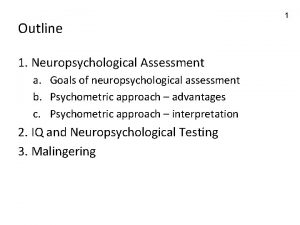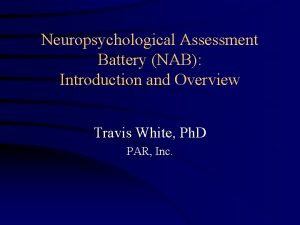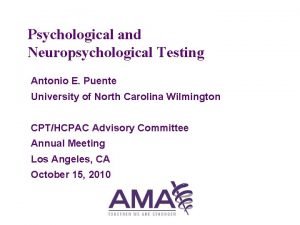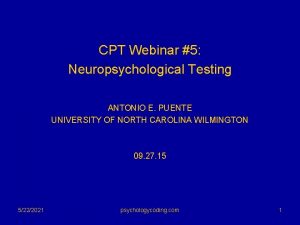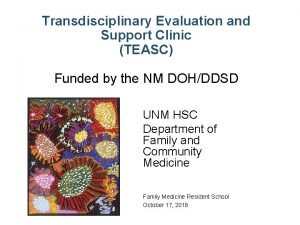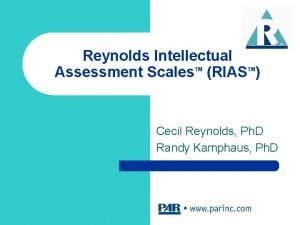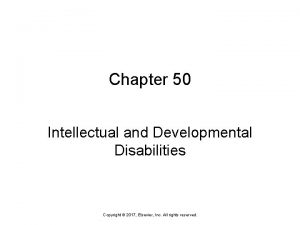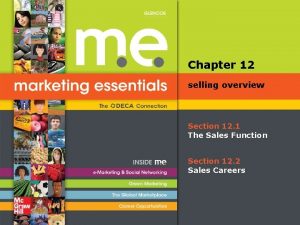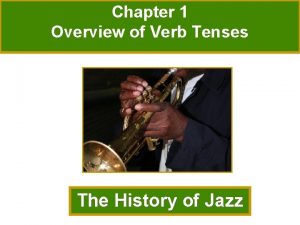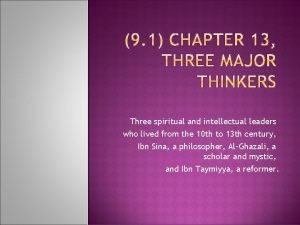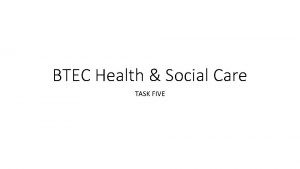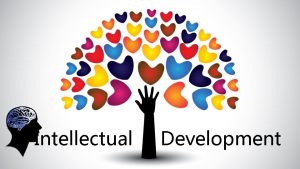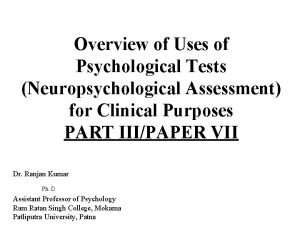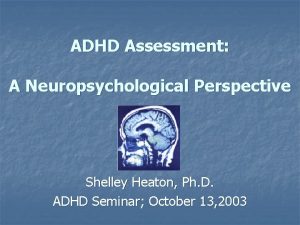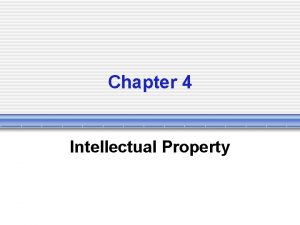Chapter 9 Intellectual and Neuropsychological Assessment Assessment Overview






















- Slides: 22

Chapter 9 Intellectual and Neuropsychological Assessment

Assessment Overview • Tests described in this chapter are related to cognitive functioning in some way – Intelligence tests measure intellectual abilities – Achievement tests measure accomplishments in academic areas – Neuropsychological tests focus on cognitive dysfunction, often from brain injury or illness

Intelligence Testing • Theories of intelligence – Is intelligence one thing or many things? • Charles Spearman—”g” for general (single) intelligence • Louis Thurstone—intelligence is plural abilities that may not relate to each other • Hierarchical models of intelligence blend singular and plural theories

Intelligence Testing (cont. ) • More contemporary theories of intelligence – James Cattell—two separate intelligences • Fluid intelligence—ability to reason when faced with novel problems • Crystallized intelligence—body of knowledge accumulated through life experiences – John Carroll—three-stratum theory • “g, ” 8 broad factors, 60 specific abilities

Wechsler Intelligence Tests • Originally created by David Wechsler in early 1900 s • Currently, there are three Wechsler IQ tests – Wechsler Adult Intelligence Scale—Fourth Edition (WAISIV) – age 16 -89 – Wechsler Intelligence Scale for Children—Fourth Edition (WISC-IV) – age 6 -16 – Wechsler Preschool and Primary Scale of Intelligence— Third Edition (WPPSI-III) – age 2 -7

Wechsler Intelligence Tests (cont. ) • Similarities among the three Wechsler IQ tests: – Yield a single full-scale intelligence score • Also yield 4 index scores: Verbal Comprehension, Perceptual Reasoning, Working Memory, Processing Speed • Also yield about a dozen specific subtests scores – One-to-one, face-to-face administration

Wechsler Intelligence Tests (cont. ) • Similarities among the three Wechsler IQ tests (cont. ): – Share a core of subtests: • • • Vocabulary Similarities Information Comprehension Block Design Picture Completion Matrix Reasoning Coding Symbol Search

Wechsler Intelligence Tests (cont. ) • Similarities among the three Wechsler IQ tests (cont. ): – Mean of 100 for full scale and index scores, and 10 for subtests – Large sets of normative data – Impressive psychometric data to support reliability and validity – Approach to interpretation: full scale IQ first, followed by increasingly specific scores and patterns

Stanford-Binet Intelligence Scales— 5 th Edition (SB 5) • Dominated in early 1900 s until Wechsler’s tests began to compete • Like Wechsler tests in many ways – Face-to-face, one-to-one administration – Single overall IQ score, 5 factor scores, many more subtest scores – Mean score is 100

Stanford-Binet Intelligence Scales— 5 th Edition (SB 5) (cont. ) • Unlike Wechsler tests in some ways: – One test covers whole lifespan (ages 2 -85+) – Subtests include extensions at high and low end (useful for assessing giftedness or mental retardation) – Different subtests and factors – Has become less commonly used than Wechsler tests, but still highly regarded and used

Cultural Fairness in Intelligence Tests • Some subtests may place people from minority cultural groups at a disadvantage – Verbal subtests especially – Both Wechsler tests and Stanford-Binet have made improvements in recent editions

Cultural Fairness in Intelligence Tests (cont. ) • Universal Nonverbal Intelligence Test (UNIT) – Recently created (1996) – Entirely language free – No speaking necessary for test administrator or test taker • All instructions are hand gestures • All responses are manual, not verbal – Some drawbacks: only for kids age 5 -17, limited psychometric data, more limited range

Achievement Testing • Intelligence is what a person can accomplish intellectually • Achievement is what a person has accomplished, especially reading, spelling, writing, or math

Achievement Testing (cont. ) • Achievement tests typically produce standard scores that can be easily compared to scores from intelligence tests (e. g. , mean = 100) – A significant discrepancy between a person’s achievement and expected levels of achievement is the basis for specific learning disorder • They also typically produce age- or gradeequivalency scores

Achievement Testing (cont. ) • Some achievement tests are specific to math, reading, or other abilities • Others are more global – Wechsler Individual Achievement Test—Third Edition (WIAT-III) • For ages 4 -50 • Administered face-to-face and one-on-one • Reading, math, written language, oral language

Neuropsychological Testing • Measure cognitive functioning or impairment of the brain and its specific components or structures • Additional purposes: to make prognosis, plan rehab, determine eligibility for accommodations, etc. • Often used after a head injury, a brain illness, or prolonged alcohol or drug use • Some neuropsychological tests are lengthy and comprehensive; others are brief and targeted

Halstead-Reitan Neuropsychological Battery (HRB) • Comprehensive battery of 8 neuropsychological tests • Primary purpose is to identify people with brain damage and, to the extent possible, provide detailed information or hypotheses about any brain damage identified

Halstead-Reitan Neuropsychological Battery (HRB) (cont. ) • Some of 8 tests involve sight, hearing, touch, motor skills, and pencil & paper tasks • A similar comprehensive battery of tests is the Luria. Nebraska Neuropsychological Battery (LNNB) – Similarly long and comprehensive – Emphasizes qualitative data in addition to quantitative data

Brief Neuropsychological Measures • Bender Visual-Motor Gestalt Test – Second Edition – Most commonly used neuropsychological screen among clinical psychologists – ~6 minutes to administer – Simple copying test using 9 geometric designs – A quick “check, ” followed by more tests as necessary – Can suggest brain damage in a diffuse, but not specific, way

Brief Neuropsychological Measures (cont. ) • Rey-Osterrieth Complex Figure Test – Brief pencil-and-paper drawing task, but unlike Bender-Gestalt, involves just a single, more complex figure – Also includes a memory component (recall figure and draw it again from memory)

Brief Neuropsychological Measures (cont. ) • Repeatable Battery for the Assessment of Neuropsychological Status (RBANS) – Neuropsych screen focusing on a broader range of abilities than Bender-Gestalt or Rey-Osterrieth – 12 subtests in less than half hour

Brief Neuropsychological Measures (cont. ) • Wechsler Memory Scale – Fourth Edition (WMS-IV) – Assesses memory problems due to brain injury, dementia, substance abuse, etc. – Ages 16 -90 – Assesses visual and auditory memory, immediate and delayed recall
 Goals of neuropsychological assessment
Goals of neuropsychological assessment Fixed battery approach
Fixed battery approach Psychological testing examples
Psychological testing examples Neuropsychological testing cpt
Neuropsychological testing cpt Teasc
Teasc Rias assessment
Rias assessment Chapter 50 intellectual and developmental disabilities
Chapter 50 intellectual and developmental disabilities Chapter 9 intellectual development of infants
Chapter 9 intellectual development of infants Chapter 17 overview elements and their properties
Chapter 17 overview elements and their properties A 23 year old male experienced severe head trauma
A 23 year old male experienced severe head trauma Emt chapter 14 medical overview
Emt chapter 14 medical overview Chapter 9 lesson 2 photosynthesis an overview
Chapter 9 lesson 2 photosynthesis an overview Chapter 12 selling overview
Chapter 12 selling overview Chapter 2 an overview of the financial system
Chapter 2 an overview of the financial system Chapter 1 overview of verb tenses
Chapter 1 overview of verb tenses Overview of personal finance chapter 1
Overview of personal finance chapter 1 Overview of the dentitions chapter 11
Overview of the dentitions chapter 11 Foundations in personal finance chapter 1 review answers
Foundations in personal finance chapter 1 review answers Chapter 32 an overview of animal diversity
Chapter 32 an overview of animal diversity Chapter 1 an overview of financial management
Chapter 1 an overview of financial management Chapter 1 overview of financial statement analysis
Chapter 1 overview of financial statement analysis The intellectual and spiritual leaders
The intellectual and spiritual leaders Intellectual development definition health and social care
Intellectual development definition health and social care
